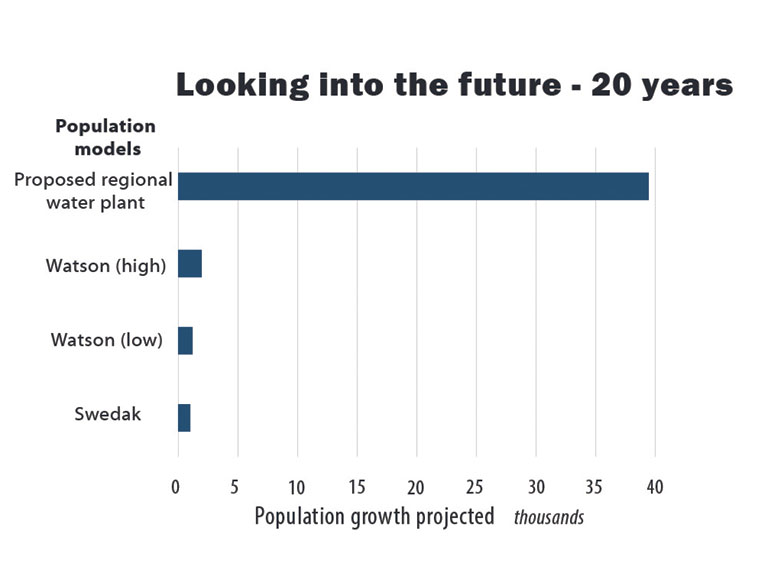County News
Ungrounded

Population professional warns Shire Hall has vastly overestimated growth predictions
Shire Hall intends to spend $300 million to expand waterworks— to accommodate a five-fold increase in population, mostly in Picton and Wellington. Much is riding on this prediction. A significant shortfall will mean existing municipal water users across the County—and possibly their rural brethren—will have to pay this bill.
Experts who earn their living measuring and predicting population growth don’t see it.
Demographic professionals don’t see a five-fold increase—8,044 to 47,500 people in Picton, Bloomfield and Wellington—in the County’s population for at least another century and a half. Likely much longer.
Demographic professionals—including the firm that consults for the municipality—predict that the rate of future population growth is more likely to average about 0.7 per cent per year. Maybe less. The forces working against population growth in Prince Edward County are nearly as strong as those favouring new arrivals.
It begs the question: Why is Shire Hall intent on buying waterworks that are many times larger than needed? Larger than may ever be needed?
The massive spending is entirely speculative, unsupported by historic trends, current new homebuilding or qualified forecasts of future growth.
Julia Swedak is a professional population modeller and policy analyst who works primarily in health care in the region. She monitors and measures utilization patterns and advises on shifting patterns in Hastings and Prince Edward County.
Swedak says the estimates to support $300 million infrastructure spending are unrealistic and improbable. Not by a little, but by a lot.
Swedak says her model shows the County population growing by about 0.6 per cent per year over the next 22 years—adding about 151 people per year. It is a rate very close to the historic average.
But Swedak says even this rate may be exaggerating growth. The County’s population is older than the region average, with death rates exceeding birth rates. This demographic feature acts as a drag on population growth—with deaths offsetting new arrivals. Furthermore, Census Canada doesn’t account for attrition between census counts. The true change in population, up or down, won’t be known until the next census is complete.
According to Swedak, the median age of a County resident is 57. A third of the population is over 65 years of age. Those aged 75 and older are growing four times faster than the rest of the County residents. Those aged 85 and older are growing faster still.
A 2010 report found Prince Edward County as the second oldest census-designated region in Ontario, the sixth oldest in Canada. The County is on track to surpass Haliburton as the census region with the highest percentage of seniors by 2036.
Swedak notes that the County population has hovered at about 25,000 folks for more than 100 years, and the that population increased by 0.8 per cent over the last census period (2016-2021). Perhaps a bit higher during the pandemic, but still less than one per cent. She notes that since 2021, population growth has slowed again to 0.7 per cent, though until the next census is completed, it isn’t clear how attrition will impact this number.
Swedak also notes that her findings track closely those produced by Watson and Associates, the demographic consulting firm used by Shire Hall. Watson’s has produced a range of growth scenarios ranging from 0.7 per cent to 1.1 per cent.
Swedak adds that the declining fertility rate in Canada (average number of children a woman is expected to have during her lifetime), combined with restrictions on immigration, will serve to dampen growth prospects in Prince Edward County.
Finally, Swedak notes that more than half the working population in this community are employed outside of the County. There are few employment opportunities to support relocation to this community, which acts as another drag on population growth.

From a “common sense” point of view, it seems logical that the main demographics for the foreseeable future for the County (in terms of full-time residents) will be retirees, farmers and fishers, wineries and employees of the wineries, hospitality industry, and some relatively small-employment services such as Quinte Health Care, some long term care facilities, and the County itself. There are certainly some trades persons, but anyone who does not already live in the County faces a pretty serious commute to work, if they work in Belleville or points west, east or north.
The narrative that if the County spends hundreds of millions of borrowed money on infrastructure to support a doubling of population, then there will somehow be a mass influx of people to buy homes in the currently approved developments — defies “common sense”.
And the data underpinning that narrative, comes from made-up spreadsheets based on assumptions designed exclusively to convince the County to part with precious taxpayer money.
People move here largely to escape the urbanization that is typical of the GTA suburbs. If that’s the direction Council and the Mayor continue to go, then those people will leave and continue their search elsewhere. Because they can.
And those that stay, will face crushing debt and skyrocketing property taxes. How does that make any sense at all?
Quote:
“People move here largely to escape the urbanization that is typical of the GTA suburbs. If that’s the direction Council and the Mayor continue to go, then those people will leave and continue their search elsewhere. Because they can. ”
And some of us are no longer in any position to do so.
Finally at last sanity